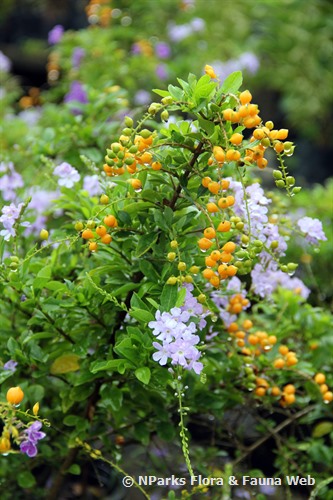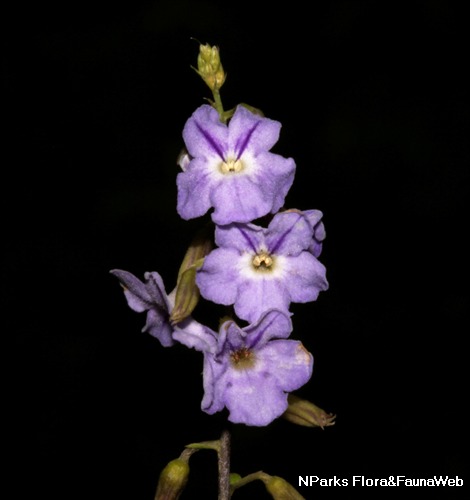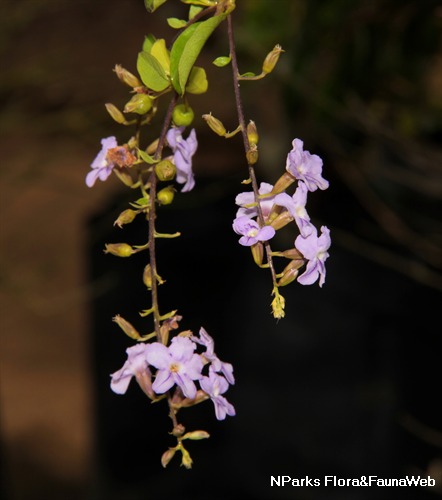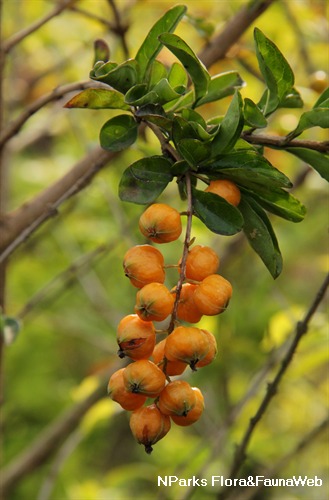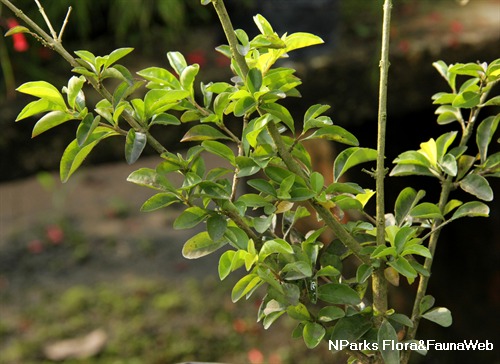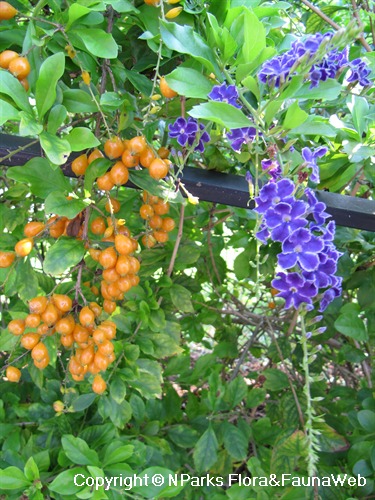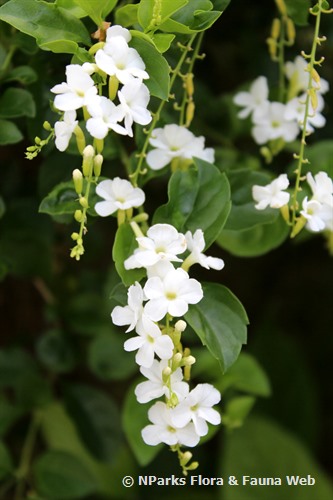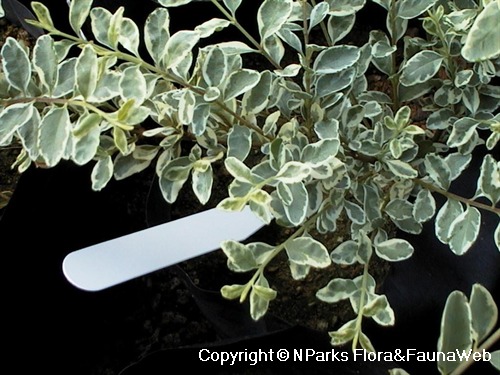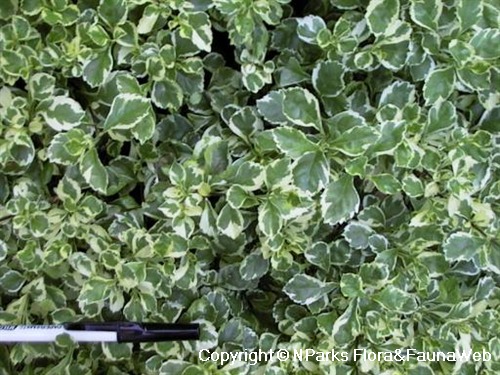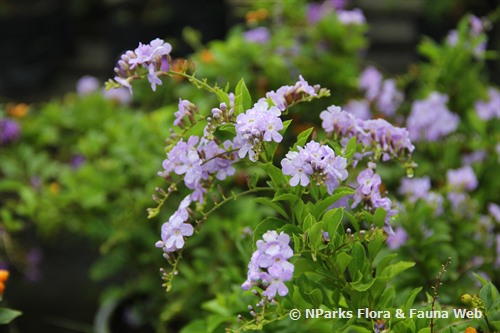
Back
Duranta erecta L.
| Family Name: | Verbenaceae |
| Synonyms: | Duranta plumiera, Duranta repens |
| Common Name: | Golden Dew-Drop, Lilac-flowered Golden Dewdrop, Pigeon Berry, Sky Flower, Brazilian Sky Flower, Kachang Puteh, Forget-Me-Not, 金露花, 假连翘, 小本苦林盘 |
Name
Classifications and Characteristics
| Plant Division | Angiosperms (Flowering Seed Plants) (Dicotyledon) |
|---|---|
| Plant Growth Form | Shrub |
| Lifespan (in Singapore) | Perennial |
| Mode of Nutrition | Autotrophic |
| Plant Shape | Irregular |
Biogeography
| Native Distribution | Tropical America |
|---|---|
| Native Habitat | Terrestrial |
| Preferred Climate Zone | Tropical |
| Local Conservation Status | Non-native |
Description and Ethnobotany
| Growth Form | Large, evergreen shrub with multiple stems and hanging branches. It has a sprawling growth habit. |
|---|---|
| Foliage | Leaves are ovate with serrate to entire leaf margin (2.5 - 7.5 cm long). |
| Flowers | Light purple, tubular flowers are 5-lobed (1.3 cm wide). Flowers are arranged in terminal or lateral clusters known as racemes (15 cm long). This species is flowers continuously throughout the year. |
| Fruit | Fruits are golden, round to slightly elongated berries (1.3 cm wide). They occur in large, hanging clusters. |
| Associated Fauna | Its flowers are visited by butterflies. |
| Cultivation | This fast-growing, low maintenance species may be planted in the ground or in large containers. Although it grows best in full sun, it is tolerant of semi-shade. This species is occasionally attacked by caterpillars, scale insects and nematodes. Propagate by seed or stem cuttings. |
| Etymology | The genus "Duranta" was named after Castore Durantes, a 16th century Italian botanist and physician. |
Landscaping Features
| Landscaping | It is suitable for streetscapes and parks for its attractive purple flowers. |
|---|---|
| Desirable Plant Features | Ornamental Flowers |
| Landscape Uses | General, Suitable for Roadsides, Parks & Gardens, Small Gardens, Hedge / Screening, Flowerbed / Border, Container Planting |
| Thematic Landscaping | Butterfly Garden |
| Usage Hazard - Cons | Spines/Thorns - Stem/Branch, Toxic Upon Ingestion |
| Usage Hazard - Cons Remarks | Its fruit are reported to be toxic to humans and pets. |
Fauna, Pollination and Dispersal
| Fauna Pollination Dispersal Associated Fauna | Butterfly-Attracting (Flower Nectar) |
|---|---|
| Pollination Method(s) | Biotic (Fauna) |
| Seed or Spore Dispersal | Biotic (Fauna) |
Plant Care and Propagation
| Light Preference | Full Sun |
|---|---|
| Water Preference | Moderate Water |
| Rootzone Tolerance | Moist Soils, Well-Drained Soils, Fertile Loamy Soils |
| Pest(s) | Chewing Insects, Sucking Insects, Nematodes |
| Propagation Method | Seed, Stem Cutting (Softwood) |
Foliar
| Foliage Retention | Evergreen |
|---|---|
| Mature Foliage Colour(s) | Green |
| Foliar Type | Simple / Unifoliate |
| Foliar Arrangement Along Stem | Opposite |
| Foliar Attachment to Stem | Petiolate |
| Foliar Shape(s) | Non-Palm Foliage |
| Foliar Venation | Pinnate / Net |
| Leaf Area Index (LAI) for Green Plot Ratio | 4.5 (Shrub & Groundcover - Dicot) |
Floral (Angiosperm)
| Flower & Plant Sexuality | Bisexual Flowers |
| Flower Colour(s) | Purple |
|---|---|
| Flower Grouping | Cluster / Inflorescence |
Image Repository
Others
| Master ID | 681 |
|---|---|
| Species ID | 1976 |
| Flora Disclaimer | The information in this website has been compiled from reliable sources, such as reference works on medicinal plants. It is not a substitute for medical advice or treatment and NParks does not purport to provide any medical advice. Readers should always consult his/her physician before using or consuming a plant for medicinal purposes. |

